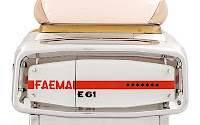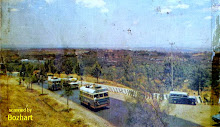Tracing the beginning tracks of espresso coffee maker is not an easy matter. Understanding the development and narrowing the meaning of espresso more or less will help us understand better about what is espresso. 'Espresso', This word now often identified with cafe. Almost every time when we go to the cafe, they have a menu of espresso in it. In fact, almost all coffee-based beverages such as cappuccino, frappe, and cafe latte, using a mixture of espresso in the making. However, did you know espresso that we drink now is not espresso drunk by the Italians in the early 1900s?
What is espresso actually? SCAA (Specialty Coffee Association of America), the organization that oversees coffee specialty in America, defined espresso as:
"Espresso is 45 ml drink served from 7-9 grams of coffee with a 88-92 Celsius degrees water temperature and a pressure of 9 bar, where the level of fineness of the coffee grounds are arranged so that the extraction time of about 22-28 seconds. When brewed, espresso will have a viscosity like warm honey and produced golden yellow crema on the coffee. Espresso is usually prepared specifically and presented directly to the consumer."
This definition is quite tight due to set various parameters that exist when making the espresso, such as volume, time, pressure, and even a visual display and presentation. But, when the world knowing espresso for the first time may be different from what is defined by the SCAA. Let us back for a moment to 1906, when the espresso machine is first created.
ESPRESSO COFFE MAKER HISTORY
Steam powered coffee makers began to be made in the 19th century when the central European nation devoted to the coffee. This machine was created after many complaints about the old-style coffee brewing process that is slow. From various types of machines are created, Italian-made machine by Angelo Moriondo be the first machine that combines a patented brewing technique with water and steam. However, Luigi Bezzera is the one to enhance the engine by adding new elements, such as the portafilter, as well as turning them into a first single shot espresso machine.Bezzera then formed a partnership with Desiderio Pavoni to enhance the machine. Pavoni bought the patent rights in 1903. Pavoni created numerous changes to enhance the machine, for example by adding a pressurized pipe to pour coffee without having to make the barista exposed to splashes of hot coffee because the suddenly released pressure.
In 1906 in Milan, Luigi Bezzera and Desiderio Pavoni introduced "Cafee espresso" when they brought the machine to the Milan Fair show. The name "Cafee espresso" means quick coffee made (express).The term of "Espresso Machine" is becoming increasingly popular then appear more unique and variety shapes. Previously, when it took about 4 minutes to brew coffee, their coffee brewing machine creation only takes about 1 minute or less. The machine capacity was calculated exceptionally for about 1,000 cups of coffee per hour.The machine capacity was calculated exceptional: 1,000 cups of coffee per hour. At that time, espresso machine uses hot steam temperatures around 100 degrees Celsius and a low pressure around 1.5-2 bar to brew coffee. Sure it is different if we compare it with the SCAA definition above.
The first espresso machine makers realize deficiencies that the water temperature produced from that machine is too high, thus make the espresso taste becomes bitter. Then appears a solution to increase the extraction pressure to get a lower temperature, so it would not make the coffee tasted hirst. However, it was a last long search of this solution and solved after World War II by Achille Gaggia.
Gaggia made a lever type espresso coffee machine which use a pistons and levers to provide water pressure of 8-10 bar. The piston must pass through a small cylinder so that the barista is able to pull the lever with easily enough, thus limiting the volume of water for extraction around 60 ml. Then it becomes the "basic standard" of the modern espresso machine. Another important point of this Gaggia creation is the 'crema', which arise when coffee was given high pressure. To convince their customers, Gaggia named the product "caffe crème". He told their customers that the coffee produced by his machine has a high quality, so it produces a "Cream or Crema" on it. While in fact at that time, he had not fully understand the significance and characteristics of 'crema' itself. What a brilliant marketing tactics.
Finally, the appearance of the modern espresso machine in 1961 that pioneered by Ernesto Valente, with his machine 'Faema E61', marked the beginning of the latest espresso machine developments as we know today. Instead of relying on manual pressure on the lever, Faema E61 use a motor pump to produce 9 bar pressure. In its development, E61 technology becomes a reference of existing espresso machine innovations.Espresso we drink recently actually is a 'caffe creme', not 'original' espresso which was first introduced by Bezzera and Pavoni.
As time goes by, the popularity of Gaggia machine creation is growing, until finally defeating the Bezzera machine creation. Espresso that appears at the beginning of 1906 itself eventually became extinct because all the cafes choose to use Gaggia machine. At that time, there was a shift definition about espresso, caffe crème where finally called as espresso.
The conclusion, the espresso that we drink now actually a caffe creme, not 'original' espresso that introduced by Bezzera and Pavoni. So, can we still sip 'original' espresso? Sure. If you want to try, you can use moka pot. The working principle of moka pot is almost the same as the 1906 Bezzera espresso machine, where the extraction uses a steam and its only 1.5-2 bar of pressure.So, want to drink an espresso or caffe creme?That is all about espresso coffe maker.
SEE ALSO:
- THE BASIC OF COFFEE BREWING METHODS
- HOW TO MAKE ESPRESSO COFFEE
- ESPRESSO MACHINE REVIEWS





